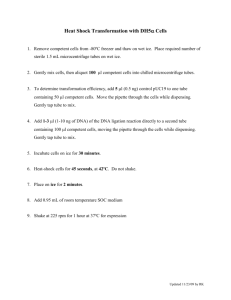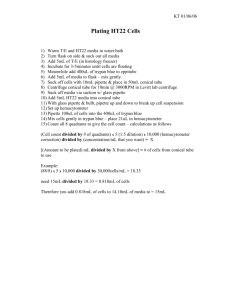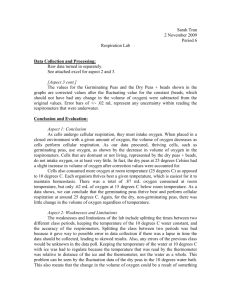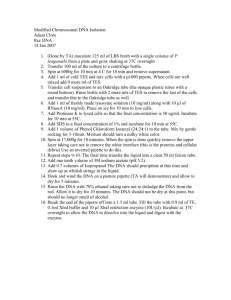SBI4U: Cellular Respiration Lab
advertisement
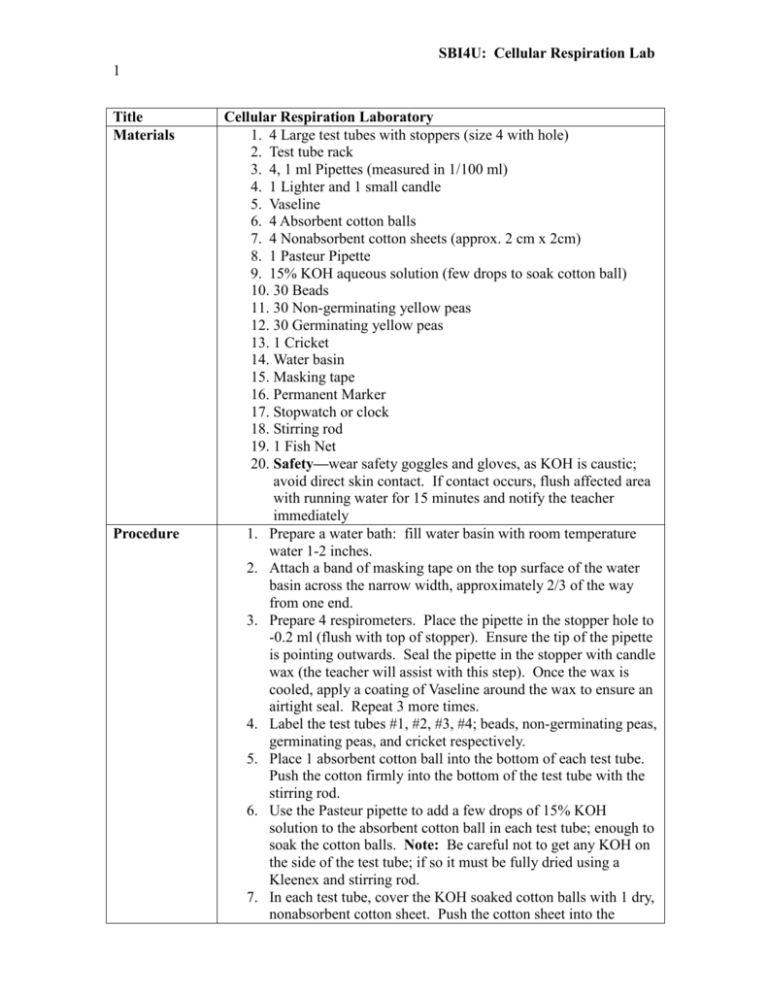
SBI4U: Cellular Respiration Lab 1 Title Materials Procedure Cellular Respiration Laboratory 1. 4 Large test tubes with stoppers (size 4 with hole) 2. Test tube rack 3. 4, 1 ml Pipettes (measured in 1/100 ml) 4. 1 Lighter and 1 small candle 5. Vaseline 6. 4 Absorbent cotton balls 7. 4 Nonabsorbent cotton sheets (approx. 2 cm x 2cm) 8. 1 Pasteur Pipette 9. 15% KOH aqueous solution (few drops to soak cotton ball) 10. 30 Beads 11. 30 Non-germinating yellow peas 12. 30 Germinating yellow peas 13. 1 Cricket 14. Water basin 15. Masking tape 16. Permanent Marker 17. Stopwatch or clock 18. Stirring rod 19. 1 Fish Net 20. Safety—wear safety goggles and gloves, as KOH is caustic; avoid direct skin contact. If contact occurs, flush affected area with running water for 15 minutes and notify the teacher immediately 1. Prepare a water bath: fill water basin with room temperature water 1-2 inches. 2. Attach a band of masking tape on the top surface of the water basin across the narrow width, approximately 2/3 of the way from one end. 3. Prepare 4 respirometers. Place the pipette in the stopper hole to -0.2 ml (flush with top of stopper). Ensure the tip of the pipette is pointing outwards. Seal the pipette in the stopper with candle wax (the teacher will assist with this step). Once the wax is cooled, apply a coating of Vaseline around the wax to ensure an airtight seal. Repeat 3 more times. 4. Label the test tubes #1, #2, #3, #4; beads, non-germinating peas, germinating peas, and cricket respectively. 5. Place 1 absorbent cotton ball into the bottom of each test tube. Push the cotton firmly into the bottom of the test tube with the stirring rod. 6. Use the Pasteur pipette to add a few drops of 15% KOH solution to the absorbent cotton ball in each test tube; enough to soak the cotton balls. Note: Be careful not to get any KOH on the side of the test tube; if so it must be fully dried using a Kleenex and stirring rod. 7. In each test tube, cover the KOH soaked cotton balls with 1 dry, nonabsorbent cotton sheet. Push the cotton sheet into the SBI4U: Cellular Respiration Lab 2 bottom of the test tube with the stirring rod until it just touches the KOH soaked cotton ball. 8. Add to test tube #1—30 beads, to test tube #2—30 nongerminating peas, and to test tube #3—30 germinating peas. Cap each test tube with the stopper fitted with the pipette (tip pointing outward) to complete the respirometer assembly. Ensure stopper firmly inserted with airtight seal. 9. Add 1 cricket to the test tube #4 and quickly cap the test tube with the stopper fitted with a pipette (tip pointing outward). Ensure stopper firmly inserted with airtight seal. Note: Respect and caution should be utilized when handling any live organism. 10. Place respirometers in water basin filled with the water with the tip of the pipette resting on the masking tape propped above the water level. 11. Allow 10 minutes for it to equilibrate. 12. Lower the tip of the pipette into the water and completely submerge each of the respirometers in the water baths. 13. Some water will enter the tip of the pipette, but it should stop quickly. If it does not stop, then check the respirometer for leaks. 14. Take an initial reading from each of the respirometers (ml) of the volume of air in the pipette by recording the position of the water in each. 15. Take reading from the respirometers at 5-minute intervals for a total of 40 minutes. 16. Remove the respirometers from the water and clean up according to instructions. The pipette in test tube #4 (cricket) should be removed from the stopper immediately otherwise water will drip into the tube. Evaluation: /8C /24I /10A /8KU 1. State the purpose of this experiment. [2KU] 2. State the hypothesis of this experiment with the expected findings and briefly justify your formulation. Be concise. [4KU] 3. Results. Data should be displayed in neat tables/graphs that are clearly labeled. Retrieve data from all the groups in this experiment. Summarize your findings and mention any trends or patterns, in paragraph form. [8C] 4. Discussion. Analyze and explain your results. [8I] Discuss sources of procedural errors. [4I] Answer the Analysis Questions listed below. Include research to support your explanations. [10A; 8I] 5. Conclusion. Provide a conclusion with the major findings and analysis of your experiment. [2KU] 6. Resources. An alphabetized and numbered works cited should list all references used. The numbers should correspond to the in-text notations. [4I] Analysis Questions: SBI4U: Cellular Respiration Lab 3 Question 1. [4I] In your experiment, a single respirometer was used for each substance being tested (dry peas, germinating peas, beads and a cricket). In another experiment, a scientist set up a respiration chamber as shown below. She placed a mouse in flask B. Into flasks A, C, and D, she poured distilled water mixed with the acid-base indicator phenolphthalein. She allowed the mouse to stay in the chamber for about an hour. Based on Figure 1, how will the scientist be able to detect whether the mouse is carrying out cellular respiration? Explain in detail. What results would the scientist expect? Figure 1. Respiration chamber. The experimental animal is placed in chamber B. Air flow travels from chamber D, to C, to B and lastly to A. Question 2. [4I] In your experiment, the temperature of the water baths were maintained at room temperature (21 degrees Celsius). If respiration of your substances were studied for a second trial, with the addition of ice to the water baths to lower the temperature to 10 degrees Celsius, what results would you predict? Explain your reasoning. Question 3. [4A] A newborn is diagnosed with a severe mitochondrial disease. Urine analysis reveals abnormally large amounts of pyruvate in the urine. Further testing shows very low levels of acetyl-CoA in the mitochondria of the infant. Propose two hypotheses to explain the test results using your knowledge of cellular respiration. Be specific and detailed. Question 4. [6A] In 1933, Maurice Tainter at Stanford University discovered that the consumption of 2,4-Dinitrophenol (DNP) facilitated significant weight loss in humans and thus DNP became popularized as an effective weight loss drug. Unfortunately, many severe adverse side effects, including fatalities, occurred from the consumption of DNP and it became banned as a weight loss drug in the US and the UK. What are the effects of DNP on the human body and specifically on metabolism? Based on your knowledge from the course material, what effect does DNP have on the mitochondria? Explain.


